Japan
Wood Products Prices
Dollar Exchange Rates
of
25th
August 2015
Japan Yen 119.22
Reports From Japan
Japan's Economy – BoJ Governor on beating deflation
The Governor of the Bank of Japan (BoJ), Haruhiko
Kuroda, recently spoke to the Japan Society in New York
and a copy of the speech „Moving Forward: Japan's
Economy under Quantitative and Qualitative Monetary
Easing‟ (QQE) was made available at:
https://www.boj.or.jp/en/announcements/release_2015/rel
150827b.htm/
The Governor maintains his optimism that the efforts of
the government and the Bank will pull Japan out of its
recessionary cycle. The speech provides a useful analysis
of the impact of monetary easing over the past two years
and the text of the opening remarks are provided below.
“More than two years have passed since the Bank of Japan
introduced Quantitative and Qualitative Monetary Easing
(QQE) to achieve the price stability target of 2 percent. Let
me briefly look back at these two years.
In the first year, Japan's economy improved impressively,
registering both rising growth and inflation. Real GDP
growth in fiscal 2013 exceeded 2 percent and annual CPI
inflation (consumer price index, all items less fresh food)
increased from minus 0.5 percent just before the
introduction of QQE to 1.5 percent in April 2014.
In contrast, in fiscal 2014, the second year after the
introduction of QQE, Japan's economic performance was a
little disappointing. One reason is that the negative impact
of the consumption tax hike in April 2014 was larger than
expected.
The tax hike brought about swings in demand and a
decrease in real income, both of which resulted in sluggish
private consumption, in particular of durable goods such
as automobiles. On the inflation front, crude oil prices
declined substantially from the beginning of autumn.
Although the oil price decline should have a favorable
impact on economic activity in the longer term, in the
short term it has a downward impact on inflation through
the decline in energy prices such as gasoline and
electricity prices. As a result, annual CPI inflation rapidly
declined toward the end of last year and has been about
zero percent this year so far.
Against this background, it is not surprising that some
wonder whether the Bank's price stability target of 2
percent can really be achieved. Has the trend toward
overcoming deflation come to an end? This is far from the
case.
Two factors -- the consumption tax hike and the
substantial decline in oil prices -- only temporally have a
downward impact on inflation.
The growth and inflation figures were strongly affected by
these factors and were indeed disappointing, but if we take
a closer look at the underlying trends, we find that
significant changes that were not observed during the
deflationary period are taking place.”

Economic indicators trending in different directions
The Japanese government‟s assessment of the state of the
economy in August says the moderate recovery continues
but that there are wide variations between the various
indicators. In summary the Cabinet Office assessment
says:
 Private consumption is holding firm Private consumption is holding firm
Private sector investment continues upwards
Corporate profits are improving
 Employment levels are improving Employment levels are improving
Consumer prices are rising moderately
but
 Exports are weakening Exports are weakening
 Industrial production is flat Industrial production is flat
 Current business conditions are neutral Current business conditions are neutral
In the short-term the Cabinet office report for August says
“The economy is expected to recover supported by the
effects of the policies while employment and income
situation show a trend toward improvement.
However, attention should be given to the downside risks
of the Japanese economy including slowing down of
overseas economies including the Chinese economy and
fluctuations in the financial and capital markets.”
For more see: http://www5.cao.go.jp/keizai3/getsureie/
2015aug.html
Japan’s robust investment in ASEAN
A recent report from the Japan External Trade
Organization (JETRO) „JETRO Global Trade and
Investment Report 2015 - New efforts aimed at developing
global business‟ shows that more and more Japanese
companies are investing in new overseas markets.
JETRO says Japan‟s outward investment has exceeded
US$100 billion for four consecutive years and much of
this is directed to ASEAN countries where investments
grew three-fold to US$20.4 billion compared to the
US$6.7 billion invested in China.
The JETRO report mentions that the weakening of the yen
is encouraging Japanese firms to invest at home rather
than in riskier overseas ventures.
Japanese investment in ASEAN could get a boost when
the ASEAN Economic Community (AEC) is finalized as
this will eliminate tariffs on a very wide range of products
by 2018 bringing benefits to ASEAN countries as well as
Japan.
For more see:
https://www.jetro.go.jp/en/news/2015/ea96c87efd06f226.h
tml
Growth strategy takes a double hit
The devaluation of China‟s currency will impact Japan as
Japanese exports will face even stronger completion from
Chinese exports. At the same time Chinese consumers will
find Japanese products have become more expensive.
Normally any risk to Japan‟s exporters would lead to a
weakening of the yen but in the current unsettled currency
markets there has been a rush to by yen which has pushed
the yen/dollar exchange rate to 119 to the dollar, a far cry
from the 124 of early August.
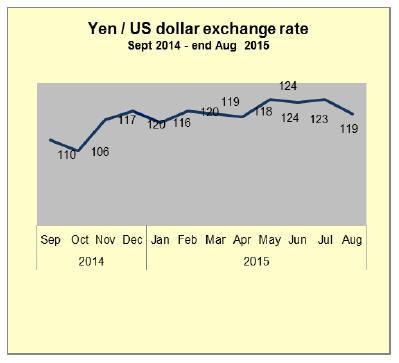
Despite strengthening yen the signals from the Bank of
Japan suggest it has no immediate plan to bring down the
exchange rate. Over the past three years the yen has been
forcefully devalued to make Japanese products cheaper in
world markets and this worked until the yuan was driven
down.
If the yen continues to rise against the US dollar and if
exports to China fall sharply the Japanese economy would
be dealt a serious blow since it depends on global exports
and in particular, exports to China.
July housing starts
Japan's Ministry of Land, Infrastructure, Transport and
Tourism released July housing starts at the end of August
showing a sharp fall from the previous month. On an
annualized basis the uly figures push down 2015
projections to 914.000 from the 1 million plus based on
figures up to June.
Compounding the negative news is that orders received by
the top house builders reversed the gains made in June.
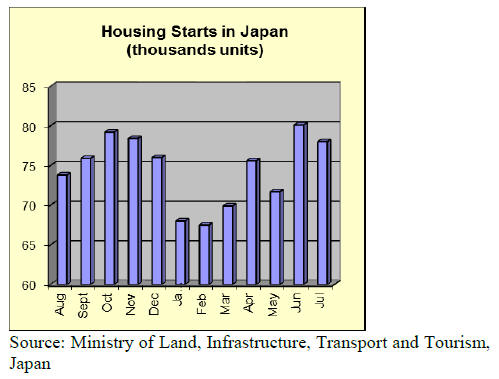
Japan’s furniture imports
Japan‟s imports of office furniture rose in July marking
the first increase in imports since January this year.
However, despite the rise, July imports are well down on
the avearge monthly imports in the first quarter of the
year.
Both kitchen and bedroom furniture imports rose in July
consolidating the monthly increase seen since the end of
the first quarter.
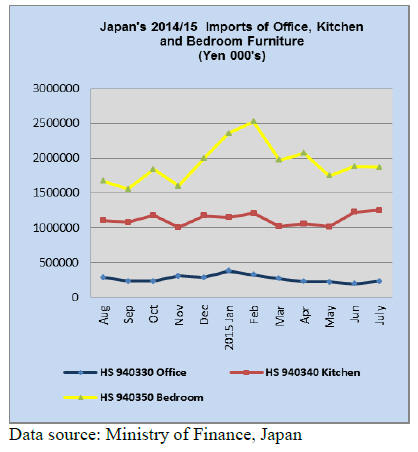
Office furniture imports (HS 940330)
July imports of office furniture jumped around 20% from a
month earlier. The top three suppliers in July were China
(47%), Portugal (17%) and Denmark (10%) which
together accounted for three quarters of all July office
furniture imports.
Office furniture imports from China were up 47% in July
and imports from Portugal also rose (+26%). Imports of
office furniture from Denmark over recent months have
been small so the rapid jump in the value of July sales (by
a factor of 10) suggests purchases of specialized items.
 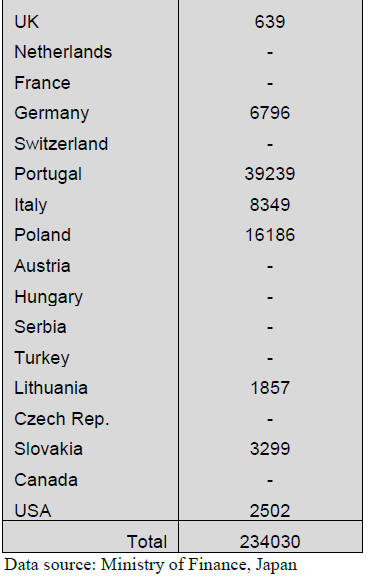
Kitchen furniture imports (HS 940340)
Once again, three countries dominate Japan‟s imports of
kitchen furniture.
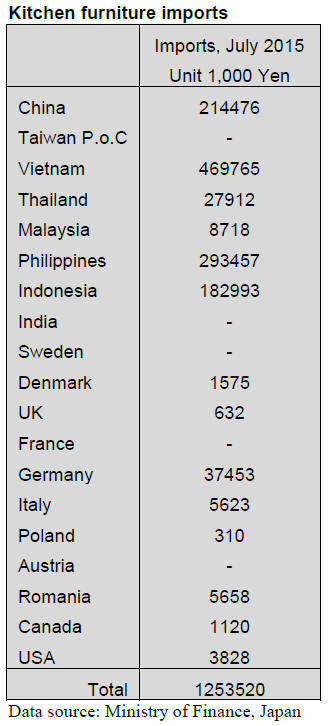
The top supplier in July, by a wide margin, was Vietnam
(37% of all kitchen furniture HS 940340 imports)
followed by the Philippines (23%) and China (17%). If
imports from the 4th ranked supplier, Indonesia are
included then over 90% of Japan‟s kitchen furniture
imports are accounted for.
Overall, July imports were about the same as in June but
supplies from Vietnam fell slightly as they did for
Malaysia and Indonesia.
Bedroom furniture imports (HS 940350)
Japan‟s wooden bedroom furniture imports (HS 940350)
had shown signs of recovering in June but July figures
were once again a disappointing reflection on consumer
sentiment when it comes to big ticket purchases.
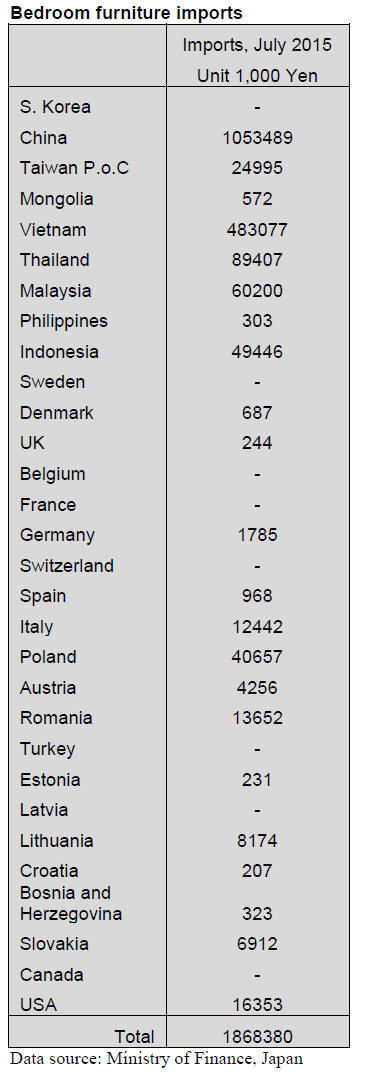
Until the housing market picks up significantly bedroom
furniture import levels will depend largely on replacement
demand.
Both China and Vietnam saw July exports of wooden
bedroom furniture to Japan decline. These two supply
countries account for over 80% of Japan‟s imports of these
products.
Trade news from the Japan Lumber Reports (JLR)
For the JLR report please see:
http://www.nmokuzai.
com/modules/general/index.php?id=7
Plywood supply for the first half year
Total plywood supply for the first six months of the year is
2,859,600 cbms, 14% less than the same period of last
year. Domestic supply is only 5.2% less but imported
plywood decreased by 20.7%. Deliveries from the three
major supplying countries (Malaysia, Indonesia and
China) all declined by about 20%.
Total imports for the first six months were 1,499,000
cbms. Average monthly imports were 248,400 cbms and if
this level continues for next six months, total 2015 imports
would be less than three million cubic metres, the lowest
since 2009.
For the first half of 2014, imports increased to meet rising
demand before the consumption tax increase in April then
the volume declined in the second half as the demand
slowed down then since last August, the yen started
depreciating rapidly.
Meantime, harvest control in Sarawak, Malaysia tightened
and the log supply dropped so that future plywood prices
have kept climbing. Consequently, the monthly import for
last May and June dropped down to about 216,000 cbms.
The supply from Malaysia has kept dropping so the first
six months supply is 631,700 cbms, 21.2% less than the
same period of last year. Total year supply would be less
than 1.3 million cbms.
Indonesian supply for the first six months is 436,200
cbms, 19.5% less. Total year supply would be less than
one million cbms, the lowest since 2010. Chinese supply is
also down by18.6% with 335,200 cbms.
Crating plywood demand of about 10,000 cbms a month
shifted to Vietnamese plywood from Chinese plywood.
Domestic production is 1,368,600 cbms, 5.2% less out of
which softwood plywood is 1,281,800 cbms, 5% less.
Average monthly production is 213,600 cbms while the
domestic shipment for the first six months is 1,269,900
cbms. June end inventory was 228,400 cbms.
First FSC certified logs from Sabah
Itochu Corporation took delivery of about 2,900 cbms of
FSC certified logs from Sabah, Malaysia from Sabah
Forestry managed timberland in Sandakan, Sabah for two
plywood mills in Niigata.
Itochu looked for FSC certified timber from beginning of
the year and urged local shippers, which handle certified
logs to have COC certificate. After COC certificate was
acquired, Itochu participated in FSC log auction through
local shippers and became successful bidder. Species are
red, white and yellow serayah. There are more FSC
certified timber in Sabah but species are mainly planted
species like acacia and falcata.
Two plywood mills have been using FSC certified
kamerere from PNG but purchase became difficult so
Itochu looked for substitution and found virgin forest of
serayah, which is suitable to make plywood.
Two plywood mills in Niigata have been using more FSC
certified wood like Indonesian veneer for face and back,
Russian veneer and PNG‟s kamerere so they give priority
for FSC certified wood in manufacturing.
South Sea (tropical) logs
Export log prices stay up high although weather continues
dry with occasional shower so weather is no factor for
reduction of the supply.
Harvest control is the largest factor in Sarawak so the
Japanese log buyers focus on Sabah logs, where there is no
legal control. Sizable harvest reduction in Sarawak will
continue then rainy season will start. Even supply of
Sabah logs will decrease when rainy season starts.
With this background, log suppliers remain bullish.
However, main buyer, India imported about 250-300 M
cbms in July, which is nearly double of normal monthly
import then monsoon season will arrive India shortly,
which reduces log consumption so that log purchase will
slow down.
If India slows down, the suppliers are not able to stick to
bullishness. Present export prices of Sarawak meranti
regular are $285-295 per cbm FOB, small meranti $265-
275 and super small $250.
Plywood markets
Domestic softwood plywood market is firming. After the
manufacturers announced production curtailment and
refused to accept low offers, the market prices sharply
reacted.
Dealers carried very little inventories in prolonging down
market then they started speculative purchases so that June
shipment was 248,500 cbms, the highest ever recorded,
about 20% higher than normal month. The inventory
dropped down by 33 M cbms.
Dealers continue ordering in July as the manufacturers
started 20-30% production curtailment since July so in last
week of July, the inventory held by the manufacturers
sharply dropped and delivery period is now uncertain.
Since this much volume shifted from the manufacturers to
distribution channels, supply shortage should not occur for
some time. Supply shortage is on all the items for the
manufacturers.
Market prices of 12 mm 3x6 panel prices are 800 yen per
sheet delivered but some demand 850 yen.
Import plywood market is not making any progress.
Malaysian plywood mills struggle to secure logs with tight
supply as a result of illegal harvest control and some mills
are forced to reduce the production. The largest supplying
mill reduces the production by half. They continue bullish.
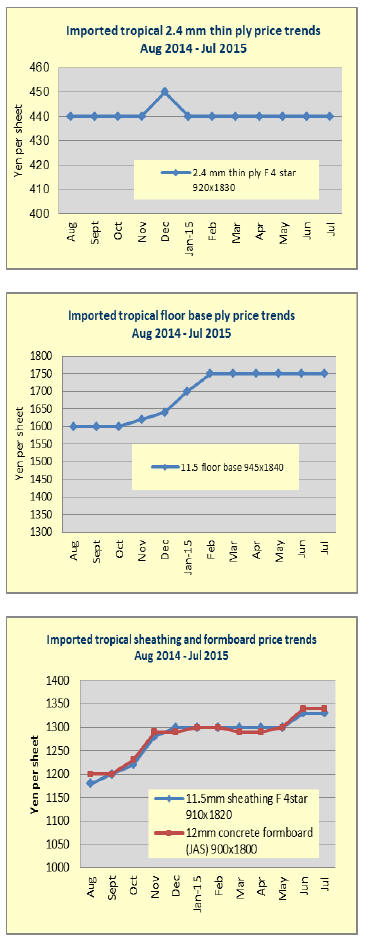
|